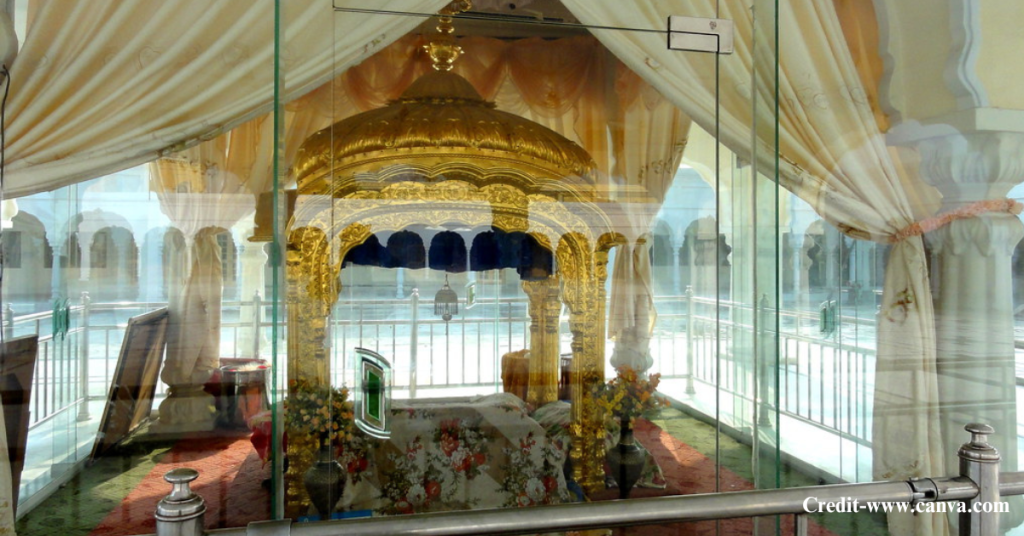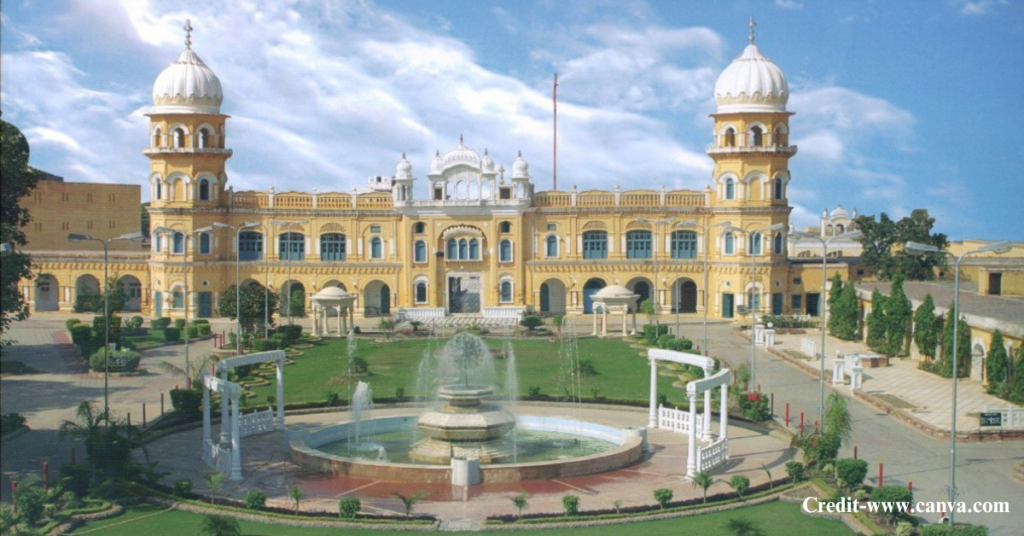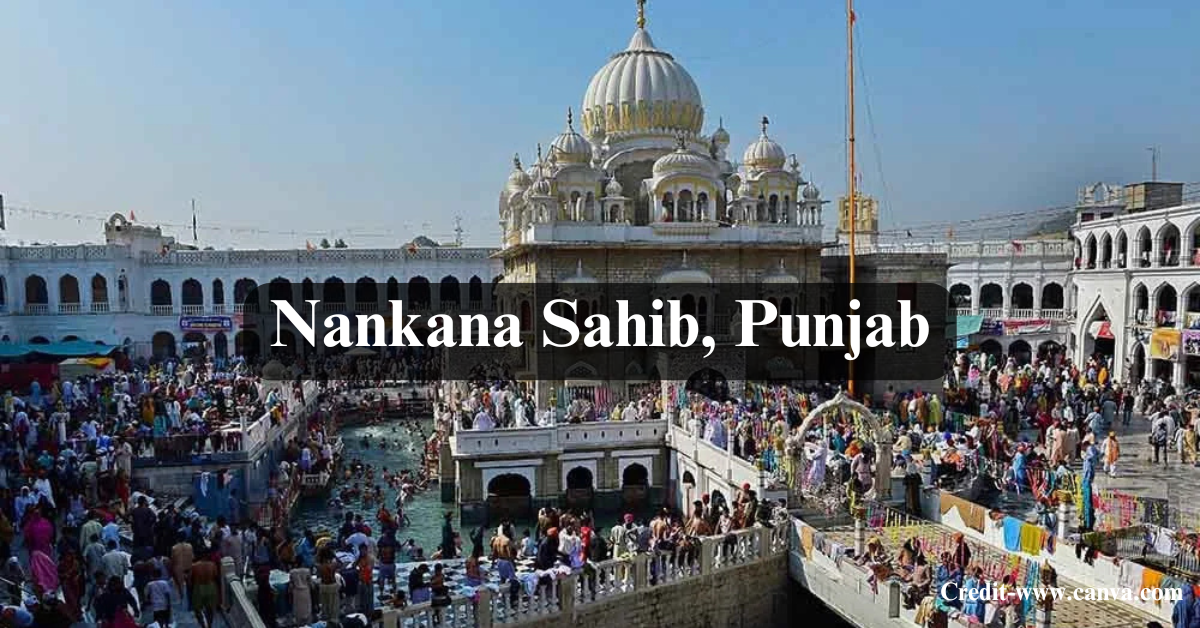If others have not yet figured out the spiritual spot on a person’s list, that person talks about Nankana Sahib. This place is not just a point on Pakistan’s map – it lives in the middle of the Sikh religion, as Guru Nanak Dev Ji was born there. Each year, many Sikhs from different countries go to this calm town in Punjab; they get meaning, history, along with a feeling that ties them to what they believe.
Table of Contents

A Quick Look at the Past: Where It All Started
Long ago, people called this area Rai Bhoi Di Talwandi – it carried the name of Rai Bhoi, the man who started it. The town changed after Guru Nanak arrived here in 1469. Rai Bular Bhatti later changed the name to Nankana Sahib. Guru Nanak’s spiritual presence affected him deeply.
Gurdwara Janam Asthan – The Journey’s Start
One important Gurdwara- Janam Asthan- is located at this place. It was constructed in the early 17th century. Maharaja Ranjit Singh later reconstructed the building. Again, the following year, he further built it. This building stands on the very place where Guru Nanak was born. When a person walks inside, the quiet and the feel of the past take hold. The gurdwara’s structure, with its plain domes, smooth marble, and large prayer rooms, shows the care people put into this holy place over hundreds of years.
Other Sacred Places: More Than Just One Shrine
While Janam Asthan is the central place people visit, it’s just the beginning. The town is full of spots that give us pieces of Guru Nanak’s early life. Here’s a simple look:
Gurdwara Patti Sahib
A gurdwara sits where Guru Nanak had his early schooling. People from the area state that he started to learn Punjabi and the Gurmukhi script at this place. The building teaches young people plus holds Punjabi culture.
Gurdwara Sri Bal Leela
This gurdwara honours Guru Nanak’s early life, his first ideas, his queries, along with the small actions that showed his deep thoughts. People like to visit the place for its calm garden and quiet area.
Gurdwara Mal Ji Sahib, Kiara Sahib, Tambu Sahib
Each of these gurdwaras offers a story from Guru Nanak’s early life. At these spots, he sat, walked, taught, or prayed; they are quiet locations that cause you to slow down, consider, and feel something larger than you.
Quba Masjid Replica: Faiths Living Together
A distinct feature of Nankana Sahib is the reproduction of Quba Masjid, which stands near the gurdwaras. People hear the azaan and kirtan at the same time. During such times, a person senses that calm can still happen.
A Painful Chapter: Saka Nankana Sahib Massacre
People talk about Nankana Sahib; they should understand what happened on February 20, 1921. On that day, Narayan Das, the shrine’s primary caretaker, and some paid men killed a group of Sikh protestors. The protestors had no weapons.
The Sikhs came to request fair management of their gurdwaras. But people attacked them roughly instead. Between 140 and 260 people died under a jand tree, plus then people burned their bodies. Some people even say that the event was worse than Jallianwala Bagh.
That exact location became a memorial. One can still view copies of the Guru Granth Sahib that show damage from bullets. Those walls tell of courage, hurt, and a shift.
Pilgrimage in the Present: Festivals, Borders, and Crowd Selfies
Each year, thousands of Sikhs come here for important events. For example, Guru Nanak Gurpurab, Vaisakhi, along with the Sacha Sauda yatra, happen here. Travel rules became less complex in 2022. More people from India, the UK, Canada, and Australia visited again.
Even with visa forms and long waits at the border, the energy stays up. People often share group pictures and write comments such as, “Langar was good – the food plus the feeling.”
The Kartarpur Corridor helped open the area, but people still worry; they think that any policy change could close the area again.
Langar and Lodging: Nankana’s Simple Luxury
Ask anyone what they loved most, and they’ll probably say “the langar.”
You get hot roti, dal, sabzi, rice, and kheer—all served fresh, all for free. There’s no bill, no VIP zone, just people from all walks of life sitting together and eating with their hands and hearts.
Would you happen to know a place to stay?
For your overnight visit, you have these options:
- Gurdwara Sarai: Free rooms for pilgrims
- Budget Guesthouses: Cheap and clean
- Rana Hunting Resort: A bit fancier, with air-conditioning
- Nankana Lake Resort: Good for those who want a quiet view by the water
After a long day walking barefoot, even a fan-cooled room feels like a blessing.
Farming, Money, and Pilgrim Impact
In Nankana Sahib, a farming town, fields outside the shrines contain wheat, sugarcane, and rice. Some orchards there produce guavas and mangoes.
When more pilgrims arrive, local business grows. Tea stalls, transport vans, and guesthouses get busy at festival times. Some people get most of their money for the year during these few months.
Baba Guru Nanak University: Learning, Culture, and Language
One big step forward is the Baba Guru Nanak University, which started in 2016 and got new plans in 2019. It’s being built for around 6 billion PKR and will focus on Sikh studies, Punjabi language, and Gurmukhi script.
This university will be a centre for learning and cultural revival, not just for Pakistanis but also for Sikhs around the world.
Language Revival at Patti Sahib
Patti Sahib also has programs to bring back the Punjabi language and Gurmukhi writing. Teachers assist children and adults as they acquire the writing system. This system links them to their past – this small victory earns little notice – it warrants greater public awareness.
Problems Still Around: Land Grabs, Bad Roads, and Policy Worries
All is not perfect. Land mafia groups have grabbed around 20,000 acres of shrine land, according to reports. That’s land meant for pilgrims and religious use, now being used for personal gain.
The government has started checking things, but progress is slow. Many small gurdwaras are dusty, broken, or have no proper lighting or water.
The visa process, though better, still depends on politics. One policy change and visits could be blocked again.
Plus, the town’s setup needs work—drainage during rain, better hospitals, and more public toilets. Pilgrims often have to manage with fundamental things.
Interfaith Harmony: A Real Story, Not Just Words
In a world where fights over religion are common, Nankana Sahib shows something better. Locals say Muslims and Sikhs live in peace here. Muslims help cook in the langar; they donate to the gurdwaras, and attend festivals.
The Quba Masjid, in addition to the Gurdwara Janam Asthan, sit near each other. They connect in spirit. People in the world could learn from that quiet togetherness.
FAQs
Where is Nankana Sahib?
Nankana Sahib is a city in Punjab, Pakistan, lying at a distance of about 80 km from Lahore.
Who was born here?
Guru Nanak Dev Ji, the founder of Sikhism, was born here in 1469.
When is the best time to visit?
People, in general, visit Nankana Sahib mostly in November and April. November is the period of Guru Nanak Gurpurab, whereas Vaisakhi is in April.
Do Indian Sikhs need a visa?
Indian Sikhs need a visa. But since 2022, pilgrim visas and group visits have simplified the process.
Is langar free?
Langar is free. It welcomes everyone, and you may eat as much as you wish.
Are there places to stay nearby?
Yes—gurdwara guesthouses, budget hotels, and resorts are available.
Can non-Sikhs visit?
Yes. All respectful visitors are welcome.

Final Thoughts
Nankana Sahib is a place where history, faith, and culture gather. People visit to see where Guru Nanak was born, but they also find peace, learn, and link with others.
From meals in the langar to deep prayers, from its long history to hopeful steps forward, the city shows the power of being together and of belief – it faces problems, but its spirit endures.
If you go, you will not just see a shrine. You will sense something that stays with you.

